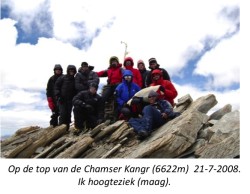
When I was young, I was able to drive with Marc and Wilfried to Arolla on a Friday evening, climb the next morning to the Cabane des Vignettes (3158m) and drink a quiet beer there while Wilfried involuntarily emptied his stomach in the strong upwind of the (then) very airy outside toilet. The next day we did the Pigne d'Arolla (3796m) without altitude problems.
I also went with Vic and Luc the day after I arrived in Breuil Cervinia to the Rifugio Teodulo (3317m) to climb the Breithorn (4165m) the next day. I felt some vague headache around 3800 m ...
Well, those beautiful times that have remained? Now praying for mi ic must neither be inconvenient. Ende in the Weerelt Liden pain ...
(after Egidius)
Every time I approach the 3000m border, the day after arriving in the mountains, I can no longer get my legs forward and my stomach quickly makes clear that I am Belgian, ie there is a thick brick in it, and it wants to get out at every stop . Miserable. Altitude sickness So. Not of the nature that one has to be drained with pulmonary edema or something, but ... miserable. Can you do something about it?
Altitude sickness is caused by a lack of oxygen in your body. The higher you go, the less oxygen in the air, and therefore the more trouble your body has to get enough oxygen. Over a height difference of 0 to 5500m there is more than half the amount of oxygen. The body tries to adjust by binding more oxygen to the hemoglobin in the red blood cells. But that does not work equally well with everyone. There are major differences between people in terms of adaptability. Apparently about 15% of people already suffer from altitude sickness at 3000m. From 3500 m that is already 35% and from 4500 m 50%.
Beginning signs are headache, usually immediately upon getting up (looks like a hangover), tiredness, and shortness of breath with exertion. One has no appetite, is nauseous and dizzy, and hands, feet and face can swell. Typically, people also sleep worse on altitude during the first few days due to an increased heart rate. Please note, do not take sleeping pills because they increase the risk of altitude sickness. If symptoms get worse such as vomiting and very severe headaches, hallucinations, balance disorders, cough, increasing shortness of breath, blue lips and nails etc. then you need to intervene very quickly and certainly not rise further but fall as quickly as possible.
How can you prevent altitude sickness?
The best solution is to first stay at a somewhat lower altitude (+2000 m) for a few days. Do not take sleeping pills. Do not smoke. Drink a lot (but no excess of alcohol) and plenty of food (carbohydrates). Above 3000m a maximum of 500m / day rise (some sources say a maximum of 300m). After every 1000m, two nights rise at the same height. Above the 4500m a maximum of 200m / day rise.
How do you ever reach a summit?
What if you don't have the time to acclimatize for a long time
but definitely want to reach the top?

Then you have the following possible solutions:
Medication, including the best known drug acetazolamide, brand name Diamox®. A disadvantage of this is that you quickly get 'tingling' feet or fingers, which is a very unpleasant feeling I have experienced. Viagra (I have no experience with it 😉 ) can apparently be used if lung oedema would occur at high altitude and one cannot descend quickly. More and more professional sportsmen and women are using these pills because they are said to improve performance by increasing the blood flow to the lungs, which then take in more oxygen. There are also various homeopathic remedies. Do all this only in consultation with your doctor!
Also chewing coca leaves or drinking coca tea would help according to different stories, although I have not found clear scientific evidence of that. This is applied in Peru (see for example Jeroen Meus in his 'De Patat' episode in Peru). A Bolivian brewer has even invented coca beer for quenching thirst and combating altitude sickness ... Whether that works is doubtful if people know that alcohol is not so good.
A safe and secure way is to acclimatise your body beforehand in an altitude tent and/or with an altitude mask (see AltitudeDream.com for more info). Several stories on their website testify that it does work.
If you cannot rent a height tent but you do have time for a long expedition: Take that time to acclimatize slowly to the altitude!
No matter how strange it may sound, despite the realization that my stomach is incompatible with altitude, I keep testing them and the urge to go to the mountains and to the top, even during a long weekend, remains. Why? Hard to articulate. To say it with Petrarch (ca. 1345):
Upwards, where no mountain casts a shadow,
To the largest and most exalted summit,
Drives me a fiery desire ...
There is a lot of literature and information on the web about altitude sickness. Some examples:
- Altitude sickness.info: the website of 'Han Willems' a doctor who also wrote a good booklet "How do I stay healthy?"
- AltitudeDream.com: A lot of information on their blog. These people also rent height tents.
Ingrid De Wolf (article Bergleeuwke Juli2013, BVLB)


